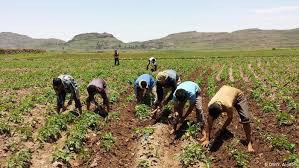SANAA, March 13 (Saba) – " Whoever has his own food has the freedom to decide "
Food security is one of the main challenges facing the state and it is a national security priority and importance grows as conflicts and wars worsen, and consider Increased crop production is one of the key ingredients for food sufficiency and food security.
Food security is also referred to as one of the main challenges that countries are constantly facing , although natural resources of land, water and human resources are available, this is not enough, so If agriculture does not achieve the target increase in production to meet the demand for food, we reach the so-called food gap, which requires importing the appropriate quantities to meet the existing shortage and deficit.
That is, achieving food security has become one of the main tasks of modern state, whose task is to provide for the needs of citizens.
In other words, consumption of food commodities in the country is linked to the total quantities of domestic production plus net imports of these goods, and If exports exceed imports, there are higher rates of sufficiency, and export earnings can therefore be used to enhance food security.
If the level of food security is reduced when resources are not available to cover imports of food commodities, in this case the State resorts to loans and subsidies to cover its food imports.
Agriculture in Yemen
The agricultural sector is closely linked to food security, and based on this fact, the figures indicate that the agricultural sector is one of the most important sectors of the Yemeni economy, as the second productive sector after the oil sector, the agricultural sector contributes an average rate of about 14% of GDP, and government statistics in Yemen reflect the importance of the sector, as it is estimated workforce is to be 54% of the country's total workforce.
The agricultural sector also contributes to population stability by reducing internal migration, where about 70% of the total population lives in rural areas.
During the past three decades, Yemen has witnessed many attempts to develop food and agricultural production of general. So,that the reality indicates that there is a decline in self-sufficiency rates in many food groups, primarily cereals, legumes, meats, dairy and other major products.
On the other hand, some agricultural products have witnessed remarkable successes through increased production and great rates through which it achieved self-sufficiency by 90%.
In this context, the following two experiences can be mentioned: the Agricultural Development and Food Security Plan 2005, that Prepared by the Ministry of Agriculture and Irrigation, these experiments included a set of food security goals in the first medium-term development plans (2006-2010) and the second long-term (2006-2015) in the field Agriculture, irrigation, water, health, education and other related.
Despite the importance of previous plans, the statistics and figures clearly indicate that there is a real stumble in the agriculture sector, and that there are multiple obstacles to the renaissance of the agricultural sector, so dozens of studies and researches have shed new and new dimensions and in the forefront:
- Weak human resources capacity.
- Limited resources and low productivity.
- Inappropriate marketing systems.
-The necessary infrastructure is Insufficient.
- Absence and lack of production technology.
- Lack of adequate agricultural services.
- Declining role of agricultural research and extension.
- Lack of inclusiveness and integration of strategies developed to achieve food security.
In the fact, these problems and constraints have prevented agriculture sector of making from a greater contribution to GDP.
The government's role in the agricultural sector has also declined during the previous period, although it is one of the tasks and responsibilities of the Ministry of Agriculture.
In addition of internal constraints, external variables such as climate, social factors and the security situation have had a negative impact on the improvement of self-sufficiency and food security in Yemen.
According to statistics available for 2017, Yemen imports approximately 896 agricultural varieties, while Consumption is about 3.5 million tons, of which about 100,000 tons were produced locally, or 2.8 percent.
As part of the effort to free Yemen's political decision from foreign interference, with a solid political will, the decision to establish the General Foundation for Grain Production and Development was resolution No. (366) for 2016, with the aim of achieving food sovereignty and improving self-sufficiency and a necessity to meet the various challenges facing the Republic.
The General Grain Production Corporation highlights a range of objectives it seeks to achieve are:
- - Increase grain production and gradually increase self-sufficiency to achieve self- sufficiency of grains in general and wheat in particular.
- Promoting and developing grain production and Protecting the production of local grain crops.
- Supporting and encouraging farmers in rain-fed areas to cultivate terraces and agricultural land in those areas and introduce modern agricultural techniques.
- Improving marketing, developing crop storage capacity and making a strategic stock of grains in general and wheat in particular.
- Encourage and support agricultural research aimed to developing the productivity of rain and irrigated agriculture.
Finally, food security is mainly linked to the agricultural sector" Whoever has his own food has the freedom to decide ".
Political, done by / Khaled al Hadda
Translated by Mona Zaid

| more of (Reports) |



